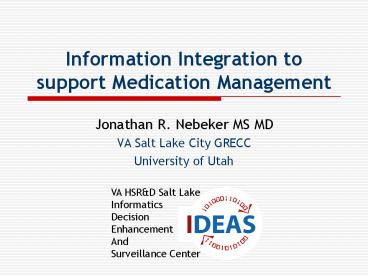Information Integration to support Medication Management - PowerPoint PPT Presentation
1 / 23
Title:
Information Integration to support Medication Management
Description:
VA HSR&D Salt Lake. Informatics. Decision. Enhancement. And ... VA Salt Lake City GRECC. University of Utah. Acknowledgements. Charlene R. Weir, PhD ... – PowerPoint PPT presentation
Number of Views:76
Avg rating:3.0/5.0
Title: Information Integration to support Medication Management
1
Information Integration to support Medication
Management
- Jonathan R. Nebeker MS MD
- VA Salt Lake City GRECC
- University of Utah
2
Acknowledgements
- Charlene R. Weir, PhD
- Frank Drews, PhD
- Molly Leecaster, PhD
- Rand Rupper, MPH MD
- Kenneth Boockvar, MD
- Kevin Meldrum
- Sandi Geary
- Mike Lincoln, MD
- Chris Nielson, MD PhD
- Brittany Mallin, MS MPH
- AHRQ R18 HS017186
- VA Salt Lake City GRECC
- VA Salt Lake City IDEAS Center
3
Overview
- The Electronic Health Record context
- Current
- Future
- How theory gets us to future
- Theoretical Framework
- Demonstration
4
Current CPRS VistA
- Emphasis on access
- Information siloed in tabs
- Physician centric
- Patient excluded
- No interface for control
5
Future CPRS VistA
- Emphasis on control
- Information integrated
- Supports all healthcare professionals and the
patient
6
Progress
- The Electronic Health Record context
- Theoretical Framework
- Joint Cognitive Systems or Cognitive Systems
Engineering - Contextual Control Model
- Demonstration
7
Cognitive System Engineering
- Contextual Control Model (CoCoM)
- Understanding/Sense making
- Goal reconciliation
- Feedback/Feed Forward Control
- Sharp-end efficiency, resiliency
- Assistive decision support
8
Decision Support v. Sense Making
- Computerized decision support is typically
normative and targets the right decision. - The CPRS of the future will emphasize an
information-rich environment that targets sense
making to support higher quality decisions in the
highly variable context of patient care.
9
Contextual Control Model (CoCoM)
- Performance in context
- Different types of behaviors predict better
outcomes - Functional not structural approach
- Not about information processing models Memory,
programs, etc. - Used in engineered systems
- ABS at Saab
- Nuclear Power Plants
10
Control Cycle in Healthcare
11
Control Modes
- Scrambled
- Lack of purposeful activity
- Opportunistic
- Addressing salient characteristics
- Tactical
- Following procedure, limited scope
- Strategic
- Broader scope and higher-level goals
12
Preliminary Conclusions
- CoCoM translates well to chronic disease care.
- High-mode characteristics have face validity for
predicting better outcomes. - Implications for software design
- Need to support efficient, rich reconstruction of
mental model of patient - Need to highlight interaction of goals and
therapies - Need to increase time horizon including feed
forward
13
Demonstration
14
Example of Integrated Control
15
Building up to Understanding
16
Snapshot of condition
17
(No Transcript)
18
(No Transcript)
19
(No Transcript)
20
(No Transcript)
21
(No Transcript)
22
Advantages of Contextual Control
- Simplification of current systems
- Medication reconciliation
- Alerts
- Allows for shared mental model of care plan by
all professions and the patient - Provides natural coordination of care
- Reduces errors?
- Facilitate the relevance of nursing documentation
23
Summary
- Theory-driven design (human factors)
- Reintegrates patient and system
- Patient-centric outcomes
- Assistive decision support
- Facilitates geriatric-style care

